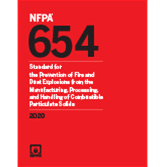 Changes and updates are everyday occurrences as processes, Standards, and Codes evolve as our usage experiences dictate necessary changes.
Changes and updates are everyday occurrences as processes, Standards, and Codes evolve as our usage experiences dictate necessary changes.
This can be seen with most everyday items, like a cellphone or a computer, and similarly, NFPA 654 has adapted with new 2020 updates. Updates arise based on new information from incidents, materials, or new methods found over time, which either amend or add new standards to existing guidelines to protect facilities further handling combustible dust.
So, what is NFPA 654-2020, you may ask?
NFPA 654 is the Standard For The Prevention Of Fire And Dust Explosions From The Manufacturing, Processing, And Handling Of Combustible Particulate Solids, 2020 Edition.
“The purpose of this standard is to prescribe technical requirements necessary to manage safety to life and property from fire, flash fire, and explosion hazards involving combustible particulate solids, including hybrid mixtures, and to minimize the resulting damage from a fire or an explosion.”
NFPA 654 is an important guideline widely used by Code officials, Health & Safety Departments, consulting engineers, and Inspectors to legislate and mitigate potential explosions in the workplace.
In 1943, NFPA 654 was a guideline specific to dust explosions in the plastic industry. NFPA 654 expanded its realm and adopted chemical, dye, and pharmaceutical dust since these items have similar explosion hazard characteristics to plastic dust. Now, the main goal of NFPA 654 is to provide safety guidelines to mitigate dust fires and explosions within facilities that have a combustible dust risk.
What Are the New Updates for NFPA 654 2020?
After the most recent update and changes in 2017, which was the beginning of the alignment between NFPA 652 & 654, the NFPA 654 2020 update has added and changed a handful of additional items, including:
- Reorganization of the existing NFPA 654 document to align with NFPA 652, Standard on the Fundamentals of Combustible Dust.
- New guidelines for ultrafine particles (nanopowders & nanoparticles).
- New guidelines for additive manufacturing.
- Requirements for static conductivity and portable vacuum cleaners previously mentioned in NFPA 652 have been moved to NFPA 654.
- The Dust Hazard Analysis (DHA) deadline (September 7, 2020) for existing processes & facility compartments have been realigned with NFPA 652.


